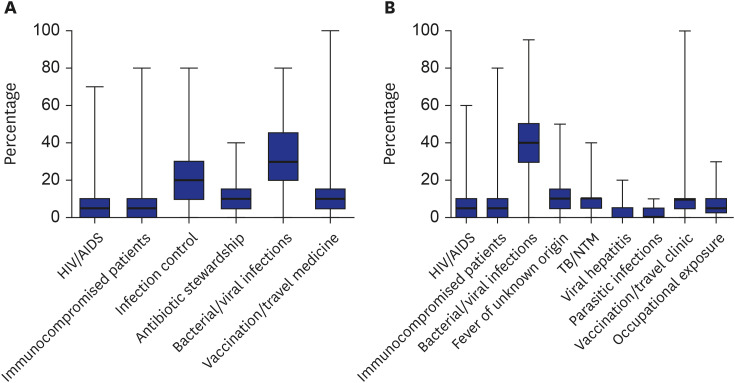2. Korean Centers for Disease Control and Prevention. Weekly updates for countries with major outbreaks. Updated 2022. Accessed March 28, 2022.
http://ncov.mohw.go.kr/en/
.
3. Jang Y, Park SY, Kim B, Lee E, Lee S, Son HJ, et al. Infectious diseases physician workforce in Korea. J Korean Med Sci. 2020; 35(49):e428. PMID:
33350186.
4. Walensky RP, McQuillen DP, Shahbazi S, Goodson JD. Where is the ID in COVID-19? Ann Intern Med. 2020; 173(7):587–589. PMID:
32491920.
5. Hussaini SM. Dearth of infectious diseases physicians as the USA faces a global pandemic. Lancet Infect Dis. 2020; 20(6):648–649. PMID:
32386608.
6. Dickstein Y, Nir-Paz R, Pulcini C, Cookson B, Beovic B, Tacconelli E, et al. Staffing for infectious diseases, clinical microbiology and infection control in hospitals in 2015: results of an ESCMID member survey. Clin Microbiol Infect. 2016; 22(9):812.e9–812.17.
7. Cassenote AJ, Scheffer MC, Segurado AA. Brazilian infectious diseases specialists: who and where are they? Braz J Infect Dis. 2016; 20(2):141–148. PMID:
26775800.
8. Hwang H, Kim B. Impact of an infectious diseases specialist-led antimicrobial stewardship programmes on antibiotic use and antimicrobial resistance in a large Korean hospital. Sci Rep. 2018; 8(1):14757. PMID:
30283084.
9. Kim YC, Kim EJ, Heo JY, Choi YH, Ahn JY, Jeong SJ, et al. Impact of an infectious disease specialist on an antimicrobial stewardship program at a resource-limited, non-academic community hospital in Korea. J Clin Med. 2019; 8(9):1923. PMID:
31717441.
10. Kim B, Park SY, Jung DS, Jung SI, Oh WS, Kim SW, et al. What should we prepare for the next coronavirus disease 2019 outbreak? A survey on the opinions of infectious diseases specialists in South Korea. Korean J Intern Med. 2020; 35(6):1270–1278. PMID:
32961636.
11. Park SY, Kim B, Jung DS, Jung SI, Oh WS, Kim SW, et al. Psychological distress among infectious disease physicians during the response to the COVID-19 outbreak in the Republic of Korea. BMC Public Health. 2020; 20(1):1811. PMID:
33246426.
12. Nori P, Bartash R, Cowman K, Dackis M, Pirofski LA. Is burnout infectious? Understanding drivers of burnout and job satisfaction among academic infectious diseases physicians. Open Forum Infect Dis. 2019; 6(4):ofz092. PMID:
31041336.
13. Brouqui P, Jouve E, Romain F, Sambuc R, Raoult D. Are infectious disease doctors better at caring for infectious diseases than other specialists? Clin Infect Dis. 2014; 58(10):1486–1487. PMID:
24599768.
14. Schmitt S, McQuillen DP, Nahass R, Martinelli L, Rubin M, Schwebke K, et al. Infectious diseases specialty intervention is associated with decreased mortality and lower healthcare costs. Clin Infect Dis. 2014; 58(1):22–28. PMID:
24072931.
15. Schmitt S, MacIntyre AT, Bleasdale SC, Ritter JT, Nelson SB, Berbari EF, et al. Early infectious diseases specialty intervention is associated with shorter hospital stays and lower readmission rates: a retrospective cohort study. Clin Infect Dis. 2019; 68(2):239–246. PMID:
29901775.
16. Rieg S, Küpper MF. Infectious diseases consultations can make the difference: a brief review and a plea for more infectious diseases specialists in Germany. Infection. 2016; 44(2):159–166. PMID:
26908131.
17. Lee J. The present and future of infection control policy in Korea. Korean J Healthc Assoc Infect Control Prev. 2020; 25(2):70–78.
18. Jeong YS, Kim JH, Lee S, Lee SY, Oh SM, Lee E, et al. Scope of a weekly infection control team rounding in an acute-care teaching hospital: a pilot study. Antimicrob Resist Infect Control. 2020; 9(1):123. PMID:
32799910.
19. Kim B, Lee MJ, Moon SM, Park SY, Song KH, Lee H, et al. Current status of antimicrobial stewardship programmes in Korean hospitals: results of a 2018 nationwide survey. J Hosp Infect. 2020; 104(2):172–180. PMID:
31513880.
20. Park SY, Chang HH, Kim B, Moon C, Lee MS, Kim JY, et al. Human resources required for antimicrobial stewardship activities for hospitalized patients in Korea. Infect Control Hosp Epidemiol. 2020; 41(12):1429–1435. PMID:
33100246.
21. Bartlett JG. A call to arms: the imperative for antimicrobial stewardship. Clin Infect Dis. 2011; 53(Suppl 1):S4–S7. PMID:
21795727.
22. Fauci AS. New and reemerging diseases: the importance of biomedical research. Emerg Infect Dis. 1998; 4(3):374–378. PMID:
9716949.
23. Collins JM, Wallender EK, Woodworth MH. Improving the infectious diseases physician scientist workforce from the view of junior investigators. Vision, transparency, and reproducibility. Clin Infect Dis. 2020; 70(1):162–168. PMID:
31231765.
24. Bonura EM, Lee ES, Ramsey K, Armstrong WS. Factors influencing internal medicine resident choice of infectious diseases or other specialties: a national cross-sectional study. Clin Infect Dis. 2016; 63(2):155–163. PMID:
27126345.
25. Kivimaki M, Jokela M, Nyberg ST, Singh-Manoux A, Fransson EI, Alfredsson L, et al. Long working hours and risk of coronary heart disease and stroke: a systematic review and meta-analysis of published and unpublished data for 603,838 individuals. Lancet. 2015; 386(10005):1739–1746. PMID:
26298822.








 PDF
PDF Citation
Citation Print
Print




 XML Download
XML Download